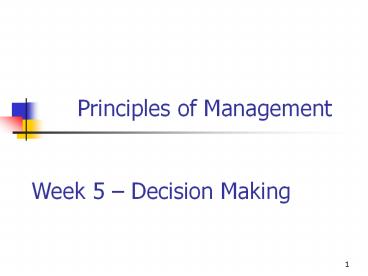Decision Making - PowerPoint PPT Presentation
1 / 16
Title:
Decision Making
Description:
satisfice - accept solutions that are 'good enough' 8. 8. Intuitive decision making ... satisficing. Implementing. Evaluating. Ethical Decisions. Social ... – PowerPoint PPT presentation
Number of Views:115
Avg rating:3.0/5.0
Title: Decision Making
1
Principles of Management
Week 5 Decision Making
2
Rational Decision Making 8-step Process
- 1. Identification of problem
- 2. Identification of Decision Criteria
- 3. Allocation of weights to criteria
- 4. Development of alternatives
- 5. Analysis of alternatives
- 6. Decide on an alternative
- 7. Implementation of decision
- 8. Evaluation of decision
3
The Decision-Making Process
Allocation of Weights to Criteria
Problem Identification
Identification of Decision Criteria
Development of Alternatives
Acer Compaq Gateway HP Micromedia NEC Sony Toshiba
My salespeople need new computers
Price Weight Warranty Screen type Reliability Scre
en size
Reliability 10 Screen size 8 Warranty
5 Weight 5 Price
4 Screen type 3
Implementation of an Alternative
Analysis of Alternatives
Selection of an Alternative
R S W W P S Acer 4 3 4 3 2 6 Compaq 3 4
5 2 6 7 Gateway 9 6 7 7 8 2 HP 3 5 6
7 6 5 Micromedia 2 2 3 4 5 4 NEC 3 4 5
6 7 2 Sony 7 5 6 4 2 8 Toshiba 3 4 5 6
7 3
Acer 125 Compaq 142 Gateway 246 HP 174 Microme
dia 103 NEC 151 Sony 192 Toshiba 154
Gateway
Evaluation of Decision Effectiveness
4
About Rational Decision Making
- Is it always possible to make rational decisions?
5
Single, well- defined goal is to be achieved
Problem is clear and unambiguous
All alternatives and consequences are known
Rational Decision Making
Preferences are clear
Final choice will maximize payoff
Preferences are constant and stable
No time or cost constraints exist
6
Bounded Rationality
- behave rationally within the parameters of a
simplified decision-making process that is
limited by an individuals ability to process
information - satisfice - accept solutions that are good
enough
7
Intuitive decision making
- Based on gut feeling
- subconscious process of making decisions on the
basis of experience, values, and emotions - does not rely on a systematic or thorough
analysis of the problem - generally complements a rational analysis
8
Types of Problems Decisions
- Well-Structured Problems - straightforward,
familiar, and easily defined - Programmed Decisions - used to address structured
problems - minimize the need for managers to use discretion
- facilitate organizational efficiency
9
Types of Problems and Decisions
- Poorly-Structured Problems - new, unusual
problems for which information is ambiguous or
incomplete - Nonprogrammed Decisions - used to address poorly-
structured problems - produce a custom-made response
- more frequent among higher-level managers
- Procedure, Rule, Policy
10
Types of Problems Level In the Organization
Programmed Decisions
Nonprogrammed Decisions
11
Things to consider . . .
- Certainty how certain is a particular outcome?
- Risk how much risk can you take?
- expected value - the conditional return from each
possible outcome - Uncertain
12
Decision Making Styles
- People differ in their decision-making styles on
at least 2 dimensions - Way of thinking rational vs. intuitive
- Tolerance for ambiguity low vs. high
- Directive
- Analytic
- Conceptual
- Behavioral
13
Common Errors in Decision Making
- Over-confidence
- Hindsight
- Self-serving
- Sunk costs
- Randomness
- Representation
- Availability
- Framing
- Confirmation
- Selective perception
- Anchoring
- Immediate gratification
14
Decision-Making Process
15
Ethical Decisions
- Social Responsibility
- Classical View
- Managements only social responsibility is to
maximize profit for stockholders - Socioeconomic View
- Managements social responsibility is to protect
and improving societys welfare - Stockholders, employees, constituents in the
envt, broader society
16
Pros and Cons
- Pros
- Public expectations
- Long-run profits
- Better environment
- Discouragement of govt interference
- Cons
- Violation of profit maximization
- Dilution of purpose
- Costs
- Lack of skills































